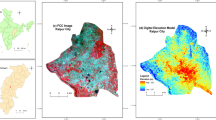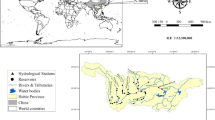Abstract
Snowmelt Runoff Model (SRM) was employed to study the impact of climate change on the hydrology of the Sindh basin. The model was calibrated for the year 2010 and validated for the years 2011–2016. Daily discharge of the river was predicted under four possible climate change scenarios, Scenario I (T + 2 °C and P + 10%), Scenario II (T + 1.5 °C, P-10%), Scenario III (T + 2 °C, P + 10%) and Scenario IV (T + 1.5 °C, P-10%). Snow covered area (SCA) was calculated from an 8-day composite Moderate Resolution Imaging Spectroradiometer (MODIS) data product (MOD10A2). The SCA reduced from approximately 90% in January to around 20% in September. The model predicted an increase of 59% in daily runoff during the late Spring and early summer season under scenario III, 45% under Scenario I, 29% under Scenario IV, and 17% under scenario II climatic conditions. The model performance was assessed using volume difference (Dv) and Nash–Sutcliffe coefficient of determination (R2). The model accuracy was satisfactory as the estimated and observed discharge matched precisely with an overall Dv of − 4.9% and the R2 remained above 0.9 for the simulation period. The peak discharge month shifted from August in 2010 to May in the simulated scenarios. A significant decrease has been observed in the river discharge in Autumn under the various climate change scenarios. The results of the study point toward an increase in the frequency and magnitude of the floods in peak snowmelt season while drought-like conditions would occur in the lean season.








Similar content being viewed by others
Data availability
The data sets used in the study can be made available on reasonable request.
References
Adib A, Zaerpour A, Kisi O, Lotfirad M (2021a) A rigorous wavelet-Packet transform to retrieve snow depth from SSMIS data and evaluation of its reliability by uncertainty parameters. Water Resour Manage 35:2723–2740. https://doi.org/10.1007/s11269-021-02863-x
Adib A, Zaerpour A, Lotfirad M (2021b) On the reliability of a novel MODWT-based hybrid ARIMA-artificial intelligence approach to forecast daily snow depth (Case study: the western part of the Rocky Mountains in the USA). Cold Regions Sci Technol 189:103342. https://doi.org/10.1016/j.coldregions.2021.103342
Ahmad ST, Ahmed R, Wani GF, Sharma P, Ahmed P (2022) Glacier changes in Sind basin (1990–2018) of North-western Himalayas using earth observation data. Model Earth Syst Environ 8(2):2567–2579. https://doi.org/10.1007/s40808-021-01246-w
Ahsan S, Bhat MS, Alam A, Farooq H, Shiekh HA (2022) Evaluating the impact of climate change on extreme temperature and precipitation events over the Kashmir Himalaya. Clim Dyn. https://doi.org/10.1007/s00382-021-05984-6
Alam A, Romshoo SA, Bhat MS, Alam1 A, Romshoo2 SA, Sultan Bhat1 M. (2011). Estimation Of Snowmelt Runoff Using Snowmelt Runoff Model (SRM) In A Himalayan Watershed. World Journal of Science and Technology (Vol. 1, Issue 9). www.worldjournalofscience.com
Bajracharya A, Bajracharya S, A. S.-S. of the T., & 2018, undefined. (n.d.). Climate change impact assessment on the hydrological regime of the Kaligandaki Basin, Nepal. Elsevier. Retrieved March 15, 2022, from https://www.sciencedirect.com/science/article/pii/S0048969717337658
Banerjee A, Chen R, Meadows ME, Sengupta D, Pathak S, Xia Z, Mal S (2021) Tracking 21st century climate dynamics of the third pole: an analysis of topo-climate impacts on snow cover in the central Himalaya using Google earth engine. Int J Appl Earth Observation Geoinform 103:102490. https://doi.org/10.1016/j.jag.2021.102490
Barnett TP, Adam JC, Lettenmaier DP (2005) Potential impacts of a warming climate on water availability in snow-dominated regions. Nature 438(7066):303–309. https://doi.org/10.1038/NATURE04141
Beven K (2011) Rainfall-runoff modelling: the primer. Wiley, Hoboken
Bhadwal S, Sharma G, Gorti G, Sen SM (2019) Livelihoods, gender and climate change in the Eastern himalayas. Environ Dev 31:68–77. https://doi.org/10.1016/J.ENVDEV.2019.04.008
Bhutiyani MR, Kale VS, Pawar NJ (2007) Long-term trends in maximum, minimum and mean annual air temperatures across the Northwestern Himalaya during the twentieth century. Clim Change 85(1–2):159–177. https://doi.org/10.1007/s10584-006-9196-1
Bookhagen B, Burbank DW (2010) Toward a complete Himalayan hydrological budget: spatiotemporal distribution of snowmelt and rainfall and their impact on river discharge. J Geophys Res. https://doi.org/10.1029/2009JF001426
Bronstert A, Kolokotronis V, Schwandt D, Straub H (2007) Comparison and evaluation of regional climate scenarios for hydrological impact analysis: General scheme and application example. Int J Climatol 27(12):1579–1594. https://doi.org/10.1002/JOC.1621
Dimri AP, Kumar A, Satyawali PK, Ganju A (2008). Proceedings of the National Snow Science Workshop, 11–12 January 2008, Chandigarh, India
Dozier J (1984) Snow reflectance from LANDSAT-4 thematic mapper. IEEE Trans Geosci Remote Sens GE-22(3):323–328. https://doi.org/10.1109/TGRS.1984.350628
Hamill TM (1998) Hypothesis tests for evaluating numerical precipitation forecasts. Weather Forecast 14(2):155–167
Georgievsky MV (2009) Application of the snowmelt runoff model in the Kuban river basin using MODIS satelliteimages. Environ Res Lett 4(4):045017. https://doi.org/10.1088/1748-9326/4/4/045017
Griggs M (2003) Absorption coefficients of ozone in the ultraviolet and visible regions. J Chem Phys 49(2):857. https://doi.org/10.1063/1.1670152
Hasson S, Lucarini V, Khan MR, Petitta M, Bolch T, Gioli G (2014) Early 21st century snow cover state over the western river basins of the Indus River system. Hydrol Earth Syst Sci 18(10):4077–4100. https://doi.org/10.5194/HESS-18-4077-2014
Immerzeel WW, Droogers P, de Jong SM, Bierkens MFP (2009) Large-scale monitoring of snow cover and runoff simulation in Himalayan river basins using remote sensing. Remote Sens Environ 113(1):40–49. https://doi.org/10.1016/J.RSE.2008.08.010
Immerzeel WW, Van Beek LPH, Bierkens MFP (2010) Climate change will affect the asian water towers. Science 328(5984):1382–1385. https://doi.org/10.1126/SCIENCE.1183188
Pachauri RK, Reisinger A (2007) Climate change 2007: synthesis report. Contribution of working groups I, II and III to the fourth assessment report of the intergovernmental panel on climate change. IPCC, Geneva, Switzerland, p 104
Jain SK, Goswami A, Saraf AK (2008) Accuracy assessment of MODIS, NOAA and IRS data in snow cover mapping under Himalayan conditions. Int J Remote Sens 29(20):5863–5878. https://doi.org/10.1080/01431160801908129
Jain SK, Goswami A, Saraf AK (2010) Snowmelt runoff modelling in a Himalayan basin with the aid of satellite data. Int J Remote Sens 31(24):6603–6618. https://doi.org/10.1080/01431160903433893
Javadinejad S, Dara R, Jafary F (2020) Climate change scenarios and effects on snow-melt runoff. Civil Eng J (iran) 6(9):1715–1725. https://doi.org/10.28991/cej-2020-03091577
Jeelani G, Feddema JJ, Van Der Veen CJ, Stearns L (2012) Role of snow and glacier melt in controlling river hydrology in Liddar watershed (western Himalaya) under current and future climate. Water Resourc Res. https://doi.org/10.1029/2011WR011590
Klein AG, Barnett AC (2003) Validation of daily MODIS snow cover maps of the Upper Rio Grande River Basin for the 2000–2001 snow year. Remote Sens Environ 86(2):162–176. https://doi.org/10.1016/S0034-4257(03)00097-X
Kothawale DR, Rupa Kumar K (2005) On the recent changes in surface temperature trends over India. Geophys Res Lett 32(18):L18714. https://doi.org/10.1029/2005gl023528
Kumar R, Manzoor S, Vishwakarma DK, Al-Ansari N, Kushwaha NL, Elbeltagi A, Sushanth K, Prasad V, Kuriqi A (2022) Assessment of climate change impact on snowmelt runoff in Himalayan Region. Sustain (switzerland). https://doi.org/10.3390/SU14031150
Martinec J (1975) Snowmelt-runoff model for stream flow forecasts. Nord Hydrol 6(3):145–154. https://doi.org/10.2166/NH.1975.0010
Martinec J, Rango A, Roberts R, Baumgartner MF (1998) Snowmelt runoff model (SRM) user’s manual. University of Berne, Department of Geography, Berne, p 84
McCuen RH, Leahy RB, Johnson PA (1990) Problems with logarithmic transformations in regression. J Hydraul Eng 116(3):414–428. https://doi.org/10.1061/(ASCE)0733-9429(1990)116:3(414)
Mishra SK, Singh VP (2003) SCS-CN Method. In: Dwara M (ed) Soil conservation service curve number (SCS-CN) methodology. Springer Netherlands, Dordrecht, pp 84–146. https://doi.org/10.1007/978-94-017-0147-1_2
Mote PW, Hamlet AF, Clark MP, Lettenmaier DP (2005) Declining mountain snowpack in western North America*. Bull Am Meteor Soc 86(1):39–50. https://doi.org/10.1175/BAMS-86-1-39
Nash JE, Sutcliffe JV (1970) River flow forecasting through conceptual models part I—a discussion of principles. J Hydrol 10(3):282–290
Negi HS, Thakur NK, Kumar R, Kumar M (2009) Monitoring and evaluation of seasonal snow cover in Kashmir valley using remote sensing, GIS and ancillary data. J Earth Syst Sci 118(6):711–720
NOAA (2017) National Centers for Environmental Information, Monthly Global Climate Report for Annual 2017, published online January 2018, retrieved on July 22, 2023. https://www.ncei.noaa.gov/access/monitoring/monthly-report/global/201713. Accessed 1 Mar 2022
Parvaze S, Ahmad L, Parvaze S, Kanth RH (2017) Climate change projection in Kashmir Valley (J and K). Curr World Environ 12(1):107–115
Prasad VH, Roy PS (2005) Estimation of snowmelt runoff in Beas Basin. India Geocarto Int 20(2):41–47. https://doi.org/10.1080/10106040508542344
Steppuhn H (1981) Snow and agriculture. Handbook of snow: principles, processes, management and use. https://ci.nii.ac.jp/naid/10021137833/. Accessed 15 Mar 2022
Rango A, Martinec J (1979) Application of a snowmelt- runoff model using Landsat data. Nord Hydrol 10(4):225–238. https://doi.org/10.2166/NH.1979.0006
Sahu R, Gupta RD (2020) Snow cover area analysis and its relation with climate variability in Chandra basin, Western Himalaya, during 2001–2017 using MODIS and ERA5 data. Environ Monit Assess 192:1–26. https://doi.org/10.1007/s10661-020-08442-8
Sheikh HA, Bhat MS, Alam A, Ahsan S, Shah B (2022) Assessing the groundwater spring potential of Sindh basin in the Kashmir Himalaya. Arab J Geosci 15(23):1710. https://doi.org/10.1007/s12517-022-10965-y
Shekhar MS, Chand H, Kumar S, Srinivasan K, Ganju A (2010) Climate-change studies in the western Himalaya. Ann Glaciol 51(54):105–112. https://doi.org/10.3189/172756410791386508
Singh P, Kumar N (1997) Impact assessment of climate change on the hydrological response of a snow and glacier melt runoff dominated Himalayan river. J Hydrol 193(1–4):316–350. https://doi.org/10.1016/s0022-1694(96)03142-3
Sitterson J, Knightes C, Parmar R, Wolfe K, Avant B, Muche M (2018) An overview of rainfall-runoff model types. International Congress on Environmental Modelling and Software. https://scholarsarchive.byu.edu/iemssconference/2018/Stream-C/41. Accessed 1 July 2021
Şorman AA, Şensoy A, Tekeli AE, Şorman AÜ, Akyürek Z (2009) Modelling and forecasting snowmelt runoff process using the HBV model in the eastern part of Turkey. Hydrol Process 23(7):1031–1040. https://doi.org/10.1002/HYP.7204
Tahir AA, Chevallier P, Arnaud Y, Neppel L, Ahmad B (2011) Modeling snowmelt-runoff under climate scenarios in the Hunza River basin, Karakoram Range, Northern Pakistan. J Hydrol 409(1–2):104–117. https://doi.org/10.1016/J.JHYDROL.2011.08.035
Tahir AA, Chevallier P, Arnaud Y, Ashraf M, Bhatti MT (2015) Snow cover trend and hydrological characteristics of the Astore River basin (Western Himalayas) and its comparison to the Hunza basin (Karakoram region). Sci Total Environ 505:748–761. https://doi.org/10.1016/J.SCITOTENV.2014.10.065
Tang Z, Wang J, Li H, Yan L (2013) Spatiotemporal changes of snow cover over the Tibetan plateau based on cloud-removed moderate resolution imaging spectroradiometer fractional snow cover product from 2001 to 2011. J Appl Remote Sens 7(1):073582. https://doi.org/10.1117/1.JRS.7.073582
Todini E (1988) Rainfall-runoff modeling—past, present and future. J Hydrol 100(1–3):341–352
Uprety M, Ochoa-Tocachi BF, Paul JD, Regmi S, Buytaert W (2019) Improving water resources management using participatory monitoring in a remote mountainous region of Nepal. J Hydrol 23:100604. https://doi.org/10.1016/J.EJRH.2019.100604
WMO (1987) Annual Report of the World Meteorological Organization 1986
Xu CY (2002) WASMOD–The water and snow balance modeling system. In VP Singh, DK Frevert (eds) Mathematical models of small watershed hydrology and applications, Water Resources Publication, pp 555–590
Zhang X, Chen R, Liu G (2022) Economic losses from reduced freshwater under future climate scenarios: an example from the Urumqi River, Tianshan Mountains. J Arid Land 14(2):139–153. https://doi.org/10.1007/S40333-022-0053-5
Acknowledgements
The authors would like to acknowledge the Irrigation and Flood control Department, Kashmir Division and IMD, Pune for providing the hydro-metrological data.
Funding
The research was funded by Ministry of Minority Affairs, Government of India, in the form of MANF-JRF scheme to the first author.
Author information
Authors and Affiliations
Contributions
MSB conceived and supervised the research idea. HAS carried out the analysis. SA wrote first draft. AA edited the manuscript. BS contributed in designing the artwork. All authors contributed and agreed to the final manuscript.
Corresponding author
Ethics declarations
Conflict of interest
The authors declare no potential conflict of interest.
Ethical approval
Not applicable.
Consent to participate
Not applicable.
Consent to publish
Not applicable.
Additional information
Publisher's Note
Springer Nature remains neutral with regard to jurisdictional claims in published maps and institutional affiliations.
Rights and permissions
Springer Nature or its licensor (e.g. a society or other partner) holds exclusive rights to this article under a publishing agreement with the author(s) or other rightsholder(s); author self-archiving of the accepted manuscript version of this article is solely governed by the terms of such publishing agreement and applicable law.
About this article
Cite this article
Sheikh, H.A., Bhat, M.S., Alam, A. et al. Modeling runoff responses to 1.5 °C and 2 °C rise in temperature in snow-fed basin of western Himalayas. Sustain. Water Resour. Manag. 9, 127 (2023). https://doi.org/10.1007/s40899-023-00910-6
Received:
Accepted:
Published:
DOI: https://doi.org/10.1007/s40899-023-00910-6




